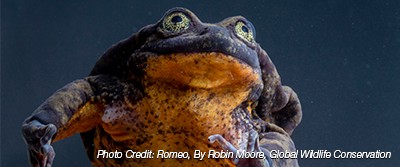A Bolivian Frog Makes a Comeback

By Christina Phillis
Habitat loss, environmental changes, and human interference have endangered many animals, even leading to the extinction of some. And once extinct, it is impossible to bring a species back. But occasionally, a species seems to return from extinction on its own. That’s exactly the case for the Sehuencas water frog. Missing for over a decade due to chytridiomycosis, a fungal disease affecting frogs, this Bolivian native came back with a splash.
After searching the Bolivian mountain forests for 10 years, scientists finally found a population of Sehuencas water frogs in December 2018, more than a decade after they had last been seen in the wild.
Bouncing Back
Scientists are not sure how the Sehuencas made their return, but they’re certainly intrigued. The chytrid fungus, believed to be responsible for the frogs’ disappearance, is endemic in moist and cool climates. The fungus affects the skin, a key organ for amphibians. The existence of microclimates or genetic resistance are just two theories posed by the team of researchers for the unexpected comeback.
“It could be that this small population has immunity. It could be an environmental factor,” said herpetologist Robin Moore, PhD, communications director at Global Wildlife Conservation in Austin, Texas, and one of the scientists who announced the discovery.
The Sehuencas is not the only frog that seems to have returned from extinction. “Many species of frogs that disappeared for years — decades in some cases — have been seen again later,” said ecologist Karen Lips, PhD, of the University of Maryland in College Park. The horned marsupial frog from Ecuador, for example, returned after being gone for over a decade.
Dr. Lips went on to explain that reappearance could occur for a variety of reasons. With fewer hosts to infect once the frogs were extinct, the fungus might have disappeared as well, allowing the frog species to slowly rebound.
What's Next
No matter how it happened, the team was happy to find the five frogs in the wild. They brought all five back to the lab for a conservation breeding program. Their new home has the same water quality and temperature as their habitat in the wild. Once acclimated, the team will give the frogs a preventative treatment for chytrid. The team hopes to find one to two more healthy populations so they can monitor the effects of the fungus in the field.
“Each case that we have a frog that we thought had succumbed to chytrid fungus but survived, it’s just an opportunity to understand a little more about how this pathogen works and the prospect for bringing these frogs back,” said Dr. Moore.
It’s possible that this discovery will help scientists better understand the extinction process and how to save other species.
Discussion Questions
- What other species have come back from the edge of extinction? What are some of the common factors that lead to their return?
- Why are scientists interested in preventing species from becoming endangered or going extinct?
Vocabulary
- Extinction
- Endangered
- Species